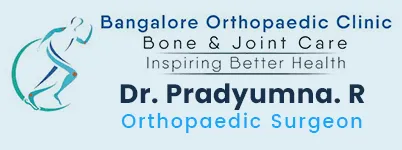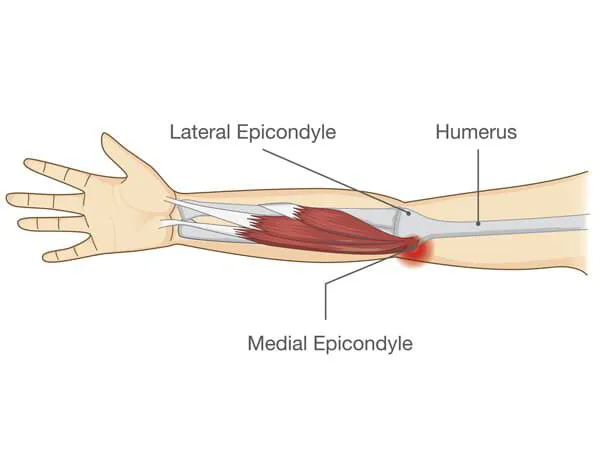Golfer Elbow Surgery
Home / Elbow / Golfer Elbow Surgery
Dr. Pradyumna R carefully evaluate your conditions and symptoms associated to your elbow pain or elbow injuries, based on the diagnostic report and scan he would suggest if so, you are a candidate for Golfer Elbow Surgery procedure, he is an highly experienced elbow pain treatment specialist provides diagnosis as well as surgical and nonsurgical treatment options at Bangalore Orthopaedic Clinic, in BTM Layout, Bangalore.
If you have any queries or would like to schedule an appointment for golfer elbow surgery or elbow pain or elbow injury treatment consultation please call +919113025188.
What is Golfer’s Elbow Surgery?
Golfer’s elbow is a condition where the tendons of your forearm become swollen and painful. It occurs on the inside of your elbow where the tendons meet the bony prominence. Golfer’s elbow is also called medial epicondylitis, or “epicondylitis lateralis.”
It is a common injury that causes pain, weakness and muscle wasting (atrophy) on the inside of the elbow. Golfer's elbow can occur from overuse of the arm and is common in golfers but also occurs in others who frequently use the arm for activities such as throwing or lifting.
Who is eligible for Golfer’s Elbow Surgery?
Golfer's elbow is a wear and tear injury to the tendons of the forearm muscles (called extensor tendons) that are located at the inner side of the elbow joint. There can be many factors that contribute towards this condition, including certain postures or positions of the hand in relation to the forearm, repetitive activities that involve excessive wrist bending, inflammation or scarring of the tendons.
The main symptoms are a deep ache and pain on the inner side of your elbow that may become so bad you have to stop doing what you planned. There may be redness, swelling and stiffness in the elbow with less range of motion.
Weakened grip leads to more pain. This can be exacerbated by gripping objects or flexing the wrist forward toward the forearm.
Tests and Diagnosis of Golfer’s Elbow Surgery
A physician will review your medical history and any daily activities that could be related to pain. You will have a physical examination of the elbow. An X-ray or Magnetic Resonance Imaging (MRI) scan may be ordered to visualize the elbow joint.
Surgical procedure of Golfer’s Elbow Surgery
Golfer's elbow can be treated in several ways. There are three main approaches: open surgery, arthroscopic surgery and as a minimally invasive endoscopic medial epicondyle release (MEER) procedure.
Surgery commonly involves making small cuts in your skin. A hand specialist will then insert a small tool that helps cut scar tissue. This can be done through open surgery or arthroscopic surgery (a minimally-invasive procedure).
After making an incision on the side of your elbow, your surgeon positions the soft tissues to view the damaged and inflamed portion of your tendon. The surgeon then cuts out this damaged and inflamed portion by removing it. Afterwards, they secure the healthy tip of your tendon into place using stitches.
After the doctor makes your cuts and cleanses your arm, they'll close your incision with stitches. Once the wound has been bound by a surgical bandage, a soft cast will be applied to slow movement. This will help stabilize your elbow as its healing. You'll need to wait 10 days before you remove the stitches and visit the doctor again.
At this point, they can check how the elbow is healing. If all goes well, you'll receive physical therapy to strengthen the muscles around your injured joint. Usually, therapy lasts up to 6 months before you can return to sports or any activity at a professional level.
Post-operative precautions after Golfer’s Elbow Surgery
Golfers elbow surgery post operative precautions are vital to a speedy recovery. To limit swelling, the arm and elbow will be placed in a supported sling and elevated above the heart.
Recovery is less painful when you properly manage pain. Our well-established pain management program gives you the relief you need with an alternative to narcotics.
Your surgeon will want you begin your physical therapy as soon as possible. Your physician will determine your rehabilitation schedule.
What are the risks & complications?
After the surgery, pain will be experienced while bending the elbow. This pain can be relieved by using proper medication and following the doctor’s instructions.
The elbow may remain swollen and bruised for several days after surgery. The elbow should be elevated for five to seven days after surgery.
A small amount of bleeding is possible after Golfer's Elbow Surgery, which will typically settle and heal within a day or two.
Bleeding stiffness is a complication that may occur following any form of elbow surgery. Prolonged resting and limitations on activities can help prevent this complication.
Infection is a rare possibility while undergoing surgery, but complications can arise if not treated properly.
Nerve injury-commonly known as golfer’s elbow-is a condition caused by repeated use of the extensor muscles of the forearm. Symptoms include pain and weakness to the hand, wrist, and forearm muscles. Permanent nerve injury is extremely rare.
In the large majority of cases, symptoms of pain and discomfort are eliminated or significantly decreased after surgery.
What are the Advantages of Golfer’s Elbow Surgery?
The main benefit of the procedure is the relief of pain in the elbow, which results in an improvement in the functional abilities of the joint. When surgery is performed correctly over 90% of patients are able to enjoy pain relief with minimal side effects.
For more information on Golfer Elbow, or tennis elbow, or removal of loose bodies, or osteoarthritis or scar tissue removal or rheumatoid arthritis or treatment of fractures or elbow injury diagnosis and treatment options available, please call +919113025188. Dr. Pradyumna R, elbow specialist serving BTM Layout, Bangalore City.

